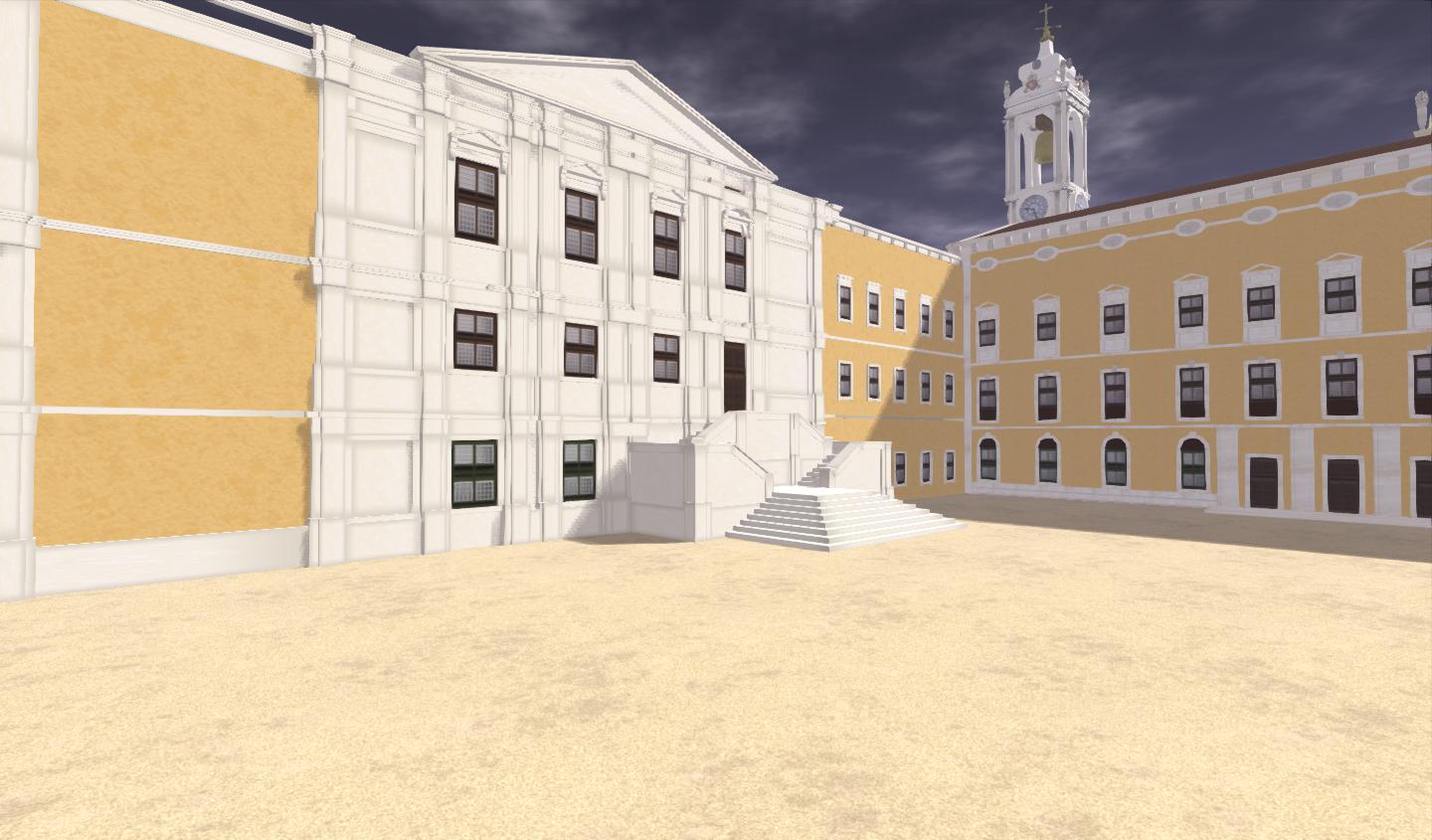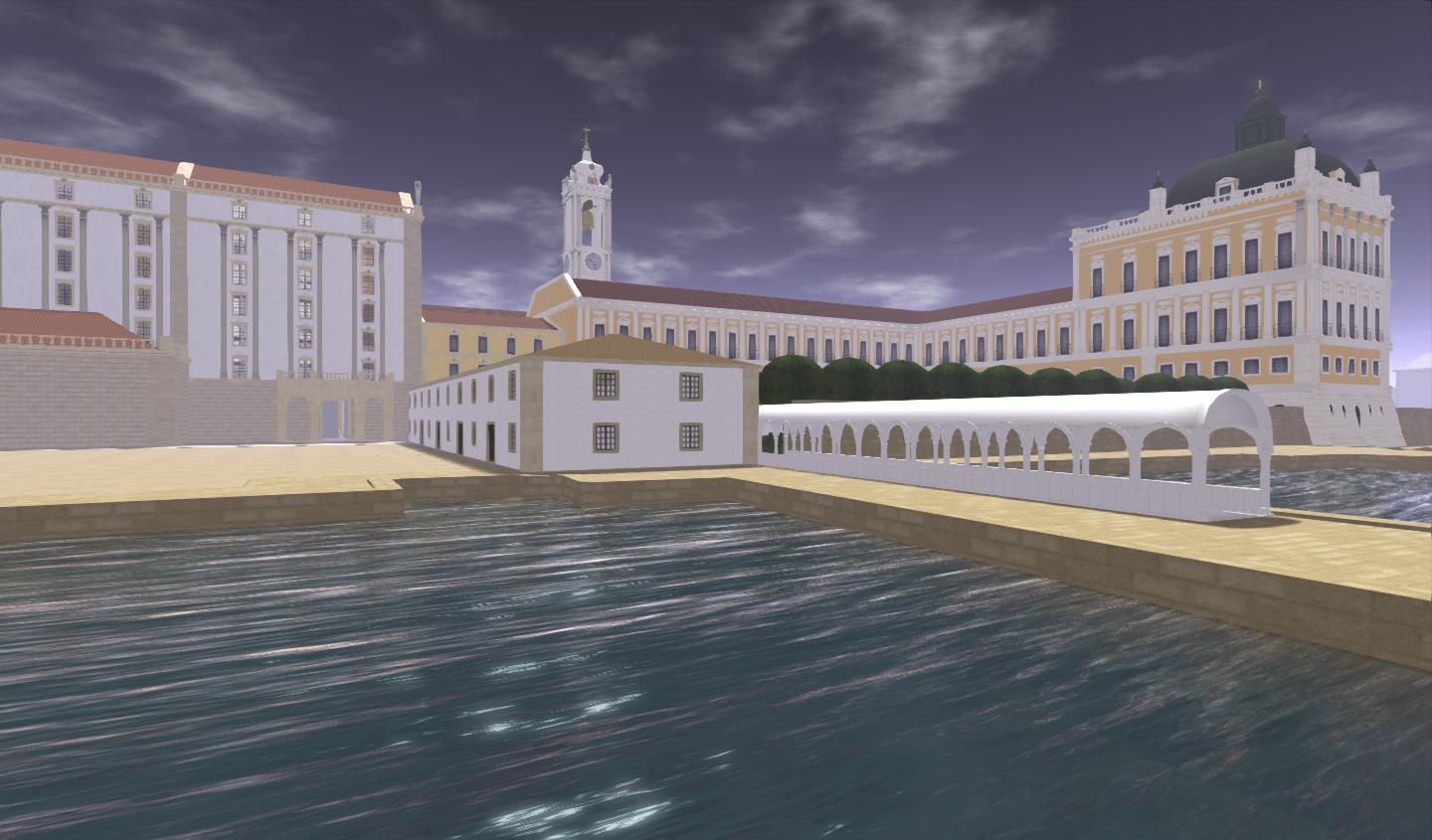
View of the Ribeira Royal Palace c. 1535. Livro de Horas de D. Manuel, fol. 25. Miniature (National Museum of Ancient Art, Lisbon).

Francisco Zuzarte (attribution). The Palace Courtyard at the eve of the 1755 earthquake (n. d.). China-ink drawing (Lisbon City Museum).

Digital ilustration of an overview of Évora´s Cathedral main chapel in the 1st half of the 16th century.

Patriarchal Church and Square. City and Spectacle: a vision of pre-earthquake Lisbon, OpenSim version 0.7.5 Dev, November 2012.

Royal Shipyard (Ribeira das Naus). Ribeira Royal Palace. City and Spectacle: a vision of pre-earthquake Lisbon, OpenSim version 0.7.5 Dev, November 2012.
ThESEUS
TimE & SpacE City MUSeum
(Transcending Time and Space: a Virtual Museum of the City)
Smart Knowledge-based cities are more than just an increasing topic of discussion regarding the planning of the future of cities. They are already a striking reality despite their diverse outreach and socio-economic and cultural features.
The digital world is permeating our daily life and generating new interactions, practices and social norms. Its widespread reach in our society is as inexorable as its development. As a consequence, we are facing the challenges of managing a fast-growing amount of information and of transforming it into sound knowledge.
In recent years, the role of cultural heritage in the Smart City network gained a growing interest. Smart Knowledge-based cities cannot function without the wealth of cultural heritage and the latter is finding ground-breaking tools for its preservation and dissemination in local and regional communities.
The ontological value of cultural heritage has long been a subject of discussion. The passage of time, the development of society and, in particular, the natural and human-made disasters have greatly impacted the epistemological boundaries of this debate. The Covid-19 crisis has stressed the role of cultural heritage in shaping the identity of societies and, consequently, the challenges facing preservation and communication. More than ever, there is the need for cultural heritage to be experienced as such.
Interaction between experts and the general public is thus paramount. Co-creativity must be explored, distancing tangible and intangible heritage from the notion of nostalgia. In other words, there is a need for an active revisitation of the past as a means of creating a more appealing and resilient future.
A city has a relevant role in cultural heritage, not only as a collection of physical elements but as a composite and complex living organism with its particular social and cultural aspects. The study of the cities’ past has greatly benefitted from the digital world. Researchers are able to collaboratively work together and swiftly gather, test and compare a large amount of data in order to formulate all-encompassing working hypothesis. Museums and City Museums have been developing an important work towards the use of multimedia, virtual reality and augmented reality, reflecting a clear positive result in communication and showing an increase in the number of visits. However, it is also important to work on interactivity and immersiveness in a level that transcends physical space, reinforces transdisciplinarity and allows for a more engaging, effective and appealing network structure, both in terms of research and dissemination.
Cyberarchaeolyg and, by definition, cyber history have a major role in this endeavour. Following this assumption and a long path of research in this area, this project aims at creating a model for the Virtual Museum of the City, enabling it to transcend time and space, whilst allowing multivocal immersive experiences and contributing to the inexorable development of both scientific research and technology.
At the starting point of this model, we will develop:
- A diachronic visualisation of the old Ribeira Royal Palace and the Palace Courtyard (the most iconic urban and architectural ensembles of pre-earthquake Lisbon) from their construction in the early sixteenth century to their ruin in November 1755.
- A visualisation of three relevant periods of the history of Évora, recreated by the project Évora 3D: the Islamic city, the Roman period and the late medieval city (fourteenth-fifteenth century).
Our research will take into account the valuable earned experience and results of our project City and Spectacle: a vision of pre-earthquake Lisbon. This model will also be open to any case-studies which follow a set of established methodological principles subject to discussion and continuous updating. .
The main goal of the project is to translate historiography into a visual operative model able to test data and, consequently, generate new one. It will allow for the memory of a city’s past to be studied and communicated as a living and lived process. The history of a city will become an immersive virtual museum which transcends the traditional display of artefacts in confined and often inhospitable spaces and, as such, it will act as an important component of the Smart City/Knowledge City network.
